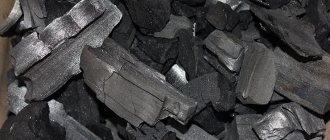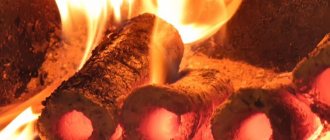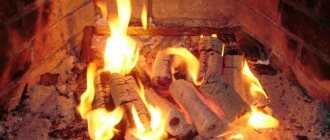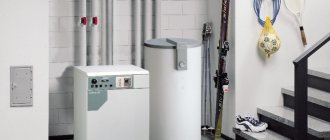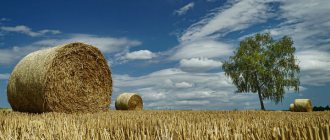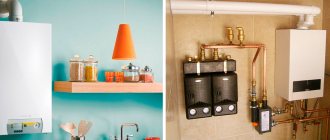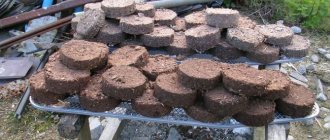Heating
Author Dmitry 779
Date
Sep 16, 2016
0
1 653
Share
It is not always possible for owners of country houses to take full advantage of the usual benefits of civilization, such as natural gas, to heat their own homes. In such cases, it is necessary to consider alternative fuels available on the market today. You can stick to the classics - wood, coal or peat, known for their high calorific value. Those who use such solid fuels know how much work it takes to use them - what it costs just to clean the house. It is much better to use pressed briquettes for heating, made from energy waste using special technologies - with high calorific value and environmental friendliness, they do not create dust in the house, their combustion takes longer, which contributes to significant cost savings.
- LiveJournal
- Blogger
Briquettes for heating are more profitable than firewood
- Advantages of briquettes for heating a private home
- Technology for making briquettes from vegetable waste
- Classification of briquetted products
- Coal for a good boiler
- Wood from birch sawdust: easy production
- Peat: consumption
- From the husks
- DIY fuel briquettes
- The secret of the popularity of compressed fuel
Advantages of briquettes for heating a private home
Thanks to special technologies, coal, peat, and wood briquettes are particularly attractive to consumers compared to conventional firewood or coal. Among the advantages of compressed fuel are the following:
- environmental safety - pressed fuel does not contain harmful impurities (resins, adhesives, etc.) inherent in coal, firewood, etc.;
- when burning, it does not smoke, does not emit carbon monoxide, does not create ash and soot, burning without a residue;
- the burning time is almost 3 times longer than the combustion time of wood, peat or coal;
- there is no spark during combustion;
- Having low humidity, this type of fuel is much lighter than natural fuel, which allows it to be used for heating residential and industrial premises, on the road, when lighting barbecues, portable stoves, for heating temporary housing (tents) on hikes, fishing, hunting, etc.;
- have low humidity (up to 12%) and increased calorific value - 1 kg of pressed fuel emits from 3500 to 8000 Kcal;
- economical due to slow combustion and increased heat transfer.
Choosing a wood briquette boiler
Choosing a long-burning boiler using pressed wood briquettes can be difficult due to the large range of products offered. Models manufactured in Russia, European countries and neighboring countries are offered on the domestic market.
To facilitate the selection of equipment, all offered boilers for burning briquettes can be divided into several categories, based on territoriality - country of manufacture:
- Germany – Bosch Solid.
- Czech Republic - ATMOS, Dakon (the company is owned by Bosch), Wattek.
- Russia – Nibe Viking, Zharstal Dobrynya, Dragon.
- Türkiye – Radijator.
- Poland – Heiztechnik.
- Italy – Ferroli.
The proposed list contains boilers for burning briquettes using the principle of pyrolysis combustion. All models are always popular, as sales statistics clearly prove.
What is better to heat a boiler - with wood or briquettes?
A solid fuel boiler using wood briquettes, despite its good thermal performance, remains a rarity in most regions of Russia. But gradually the trends are changing.
To decide what to heat a solid fuel boiler with, wood or briquettes, it is worth considering what characteristics distinguish compressed fuel:
- Relative humidity – the indicator does not exceed 8-10%. Firewood, even after drying for two years, has a moisture content of at least 20%.
- Calorific value – varies at the level of 4.5-5 kW/kg. The same characteristics distinguish pellets and coal.
- Cost-effectiveness – the efficiency of a solid fuel pyrolysis boiler using wooden briquettes exceeds by 5.3% identical indicators when using coal.
The caloric content table for wood briquettes shows that compressed fuel is superior in its characteristics to ordinary wood. The constant use of stoves is economically beneficial and increases the battery life of solid fuel boilers.
By all indicators, the use of briquettes is more profitable. There are a few more parameters to consider:
- Technological results - combustion is characterized by stability and uniformity. With normal traction characteristics, the flame is bright yellow. During the combustion process, no soot is released. The chimney warms up quickly, there are no temperature changes. As a result of these features, a decrease in condensation is observed.
- Environmental characteristics – the emitted smoke is transparent. There is a sour smell. Combustion products do not contain harmful substances or soot that negatively affect human health.
- Production characteristics – briquettes make the work of service personnel easier. Even when using slabs in classic units, the operating time from one load increases to 8 hours. In pyrolysis or long-term combustion equipment, the time increases to 20 hours.
Taking into account all the characteristics, it is better to heat the boiler not with wood, but with briquettes.
Technology for making briquettes from vegetable waste
It is unprofitable to burn fuel raw materials without processing, and the production of briquettes and their widespread use in everyday life and in enterprises is indisputable proof of this. Pressed fuel from plant waste, for the production of which wood scraps, wood chips, sawdust, sunflower husks, corn stalks, straw, etc. are used, is produced using special technologies, including:
- LiveJournal
- Blogger
Equipment for production
- RUF is a method of pressing plant mass, without special surface protection from moisture. Equipment – a press for the production of fuel briquettes in the form of bricks. The use of technically simple equipment does not require qualified personnel, so the cost of such products is low. However, due to instability to moisture, briquettes for heating of this type cannot be transported over long distances - as a result of saturation with moisture, the product loses some of its specific qualities.
- Nestro – production of fuel briquettes of elongated cylindrical shape (50×10 cm) occurs on high-performance presses, with low energy consumption. The resulting products are subject to accelerated sale and use; otherwise, due to high humidity, they lose their shape and ability to be transported.
- Extruder technology (Pini&Kay) is known as the most effective, providing the highest quality products. Extruder presses produce various types of compressed fuel, including coal briquettes with increased technical advantages, resistant to high humidity and mechanical stress. The production of briquettes on extruder (screw presses) is characterized by a high degree of heat treatment of the product, which, in combination with pressing, provides the final product with increased density due to lignin released under the influence of elevated temperatures, which has adhesive and compacting properties.
Each presented technology for the production of fuel briquettes is developed taking into account the conditions in which these products will be used. Thus, sawdust briquettes and peat briquettes, which are characterized by relatively low heat transfer, are more often used as stove briquettes for heating small rooms in private households. Popular heating devices for this type of fuel are peat boilers and stoves designed for peat briquettes for heating.
- In the form of a brick, obtained by hydropressing under pressure up to 400 bar (about 4 kgf/cm2).
- Cylindrical - about 50 cm long, 10 cm in diameter, using hydro- or mechanical pressing methods with pressure from 400 to 600 bar (4-6 kgf/cm2).
- Piney-key - with radial holes, obtained by processing on screw (extruder) presses, while simultaneously exposed to high pressure (up to 110 bar) and high temperature (250-350o C). They differ in combustion duration, increased heat transfer, density and resistance to impact.
The density of briquettes is a fundamental value that directly affects calorie content, mechanical resistance, and resistance to moisture.
- LiveJournal
- Blogger
Warehouse of briquetted products
The higher the density, the higher the listed indicators accompanying it. Which fuel briquettes are better is up to consumers to decide, in accordance with their own needs and preferences.
Comparison with firewood and benefits over them
- Greater amount of heat generated. Compared to conventional firewood, this figure is 2-3 times higher.
- Due to the minimal release of resin, the chimney needs to be cleaned half as often.
- They burn longer – 1.5-2 times. Thanks to this, European raw materials become more profitable.
- The production of fuel briquettes involves compacting waste. Due to the high density, the same mass will be placed in a smaller briquette. This allows for more convenient transportation of the material.
- Classic firewood contains 20-25% moisture, and European raw materials - 10%. Therefore, the second fuel spends less heat to evaporate the liquid.
Coal for a good boiler
The combustion temperature of hard coal can reach 1400o C, the ignition temperature is 600o C - these properties are used when conducting energy-intensive processes in ferrous and non-ferrous metallurgy, where hard coal and anthracite are traditionally used. The combustion of coal (brown) is accompanied by increased heat transfer to heat metals up to 1200o C. At the same time, studies show that when coal burns, up to 40% of volatile gases are released, and after their combustion, up to 14% of ash remains.
Coal briquettes for heating have significantly lower values for these indicators, while maintaining high combustion heat characteristics (up to 5500 kcal). Briquette is a compressed mixture of crushed coal fractions and fixative fillers with a density of 1.4 g/cm3. High calorific value and the absence of coal dust have made coal in briquettes a popular type of fuel used in private households and in enterprises where there is no centralized heat supply. Coal slag, formed during the combustion of fuel, can serve as fertilizer for plants in the area adjacent to the house.
What is the difference between briquettes and conventional solid fuel?
Fuel blocks have been used all over the world for a long time. Burning solid wood is recognized as an irrational and even wasteful use of natural resources. Pressed sawdust blocks solve this problem. As for hard coal, its screenings and coal dust are also processed. If the coal stones are small, they spill through the firebox grate. Manufacturing pressed blocks from “substandard” solves this problem.
Each type of fuel briquettes has its own characteristics, the following are considered common:
- high heat transfer;
- small amount of ash;
- less chimney clogging due to low soot emission;
- smooth, comfortable combustion;
- long smoldering mode;
- releasing less carbon monoxide into the atmosphere;
- Possibility of compact and neat storage;
- accurate calculation of the amount of fuel required.
Despite the fact that a cubic meter of briquetted fuel is more expensive than regular fuel, the high efficiency and burning time cover the difference in price. Upon detailed calculation, the cost per unit of heat for fuel made from compressed raw materials turns out to be lower.
Wood from birch sawdust: easy production
It is difficult to imagine that wood briquettes, which, unlike firewood, have increased calorific value and can maintain combustion for up to one and a half hours, can be made from sawdust, shavings and other wood waste and plant waste by processing by pressing and extrusion. Additional heating to a temperature of 250-350o C ensures increased product density, reduced humidity (up to 5.6%) and, accordingly, prolonged combustion and high heat transfer.
The production of briquettes from sawdust and plant waste is an effective way to create environmentally friendly fuel for stoves, fireplaces and solid fuel boilers used for heating residential buildings and industrial premises. This type of fuel is characterized by the absence of smoke, ash, and volatile gases that accompany the combustion of coal and wood.
In accordance with the technologies for the production of solid fuel from wood and plant waste, a machine for making briquettes from sawdust (briquetting press or extruder) is the main component of a complex of special equipment, including:
- shredders for wood and plant raw materials supplied for processing;
- drying equipment;
- conveyors designed for supplying raw materials and shipping products for storage and sale.
Which briquettes are better?
When choosing fuel briquettes for heating rooms, you should pay attention to the following:
- raw materials – it is recommended to choose briquettes made from sawdust for home heating;
- the presence of pine needles in the briquettes - if there are coniferous species in the composition (sawdust or bark particles), then due to the large amount of resin in the wood, the heat generation will take longer, however, the chimney will also clog faster. Therefore, you will have to clean the chimney much more often;
- density - the higher this indicator, the longer and more uniformly the combustion will occur;
- pressing – high-quality, well-pressed briquettes should not crumble or crumble;
- It is recommended that before purchasing a large number of briquettes, you first purchase a few “test samples” from different places and test them.
Note: Due to their properties, as well as the environmental friendliness of the material, fuel briquettes are becoming increasingly popular among owners of both country houses and residential buildings. Such solid fuel is purchased or produced independently.
DID YOU LIKE THE ARTICLE? Share with your friends!
Peat: consumption
The traditional fuel in some regions of Russia - peat - is gradually being replaced by a more efficient product for use in stoves and solid fuel boilers. Peat briquettes for heating are produced using new technologies, including grinding, dispersing, drying and pressing. The resulting biofuel has a smoldering time (4-10 hours) with the release of a large amount of heat (up to 4500 kcal/kg) and can be used for night heating in homes.
- LiveJournal
- Blogger
Peat-based fuel is fairly strong pieces of the same shape.
The production of peat briquettes does not require high costs - inexpensive equipment for their production, including drying units and presses, pays for itself quite quickly. Pressed peat fuel can be stored for a long time, it is convenient to transport, and its high calorie content makes pressed peat indispensable for use in centralized boiler houses for heating residential, construction and commercial facilities.
Charcoal briquetting
When producing charcoal, about a quarter of it turns out to be substandard - small pieces and dust. To turn this waste into income, you can make briquettes from them. Charcoal briquettes can also be made at home; if necessary, you can make raw materials for this (charcoal yourself). The principle of briquetting charcoal is no different from the formation of the same fuel from coal:
- Substandard coal is crushed.
- Mix with binder. In this case, a regular starch paste will do the job well. The output should be a slightly moist mass. Some of the dust rolls into small lumps.
- The resulting mixture is fed into a press, where briquettes are formed.
This video clearly shows the entire technology of charcoal briquetting, but the guys created a form specifically for the customer (church tablets made from charcoal for incense were ordered). Similarly, you can make a mold of any configuration.
Conclusions. Briquettes from coal crumbs and dust (stone and wood) can be made at home. It is difficult to achieve commercial results (only through automation, and therefore expensive equipment), but for home use it is possible to make a simple installation.
From the husks
The briquetting system for various types of fuel also includes the production of briquettes from sunflower husks and small agricultural waste. Until recently, husks were used for heating private houses, mainly as a means of kindling - small particles burn quickly, bringing virtually no heat. Unlike unprocessed raw materials, pressed husk fuel is a valuable fuel with a high calorific value (up to 5900 kcal/kg), which is widely used for heating residential and industrial premises. For comparison: the amount of thermal energy released during the combustion of 1 ton of husk briquettes is equivalent to the combustion energy of 500 liters of diesel fuel or 1.6 tons of firewood. Minerals. The minerals contained in the husk ash are beneficial for plants and are used in fertilizers.
The secret of the popularity of compressed fuel
If we summarize all the positive qualities of various types of briquettes, we can say that their use is much more rational and productive than heating rooms with traditional fuel - coal or wood. The only negative that keeps many from purchasing is the higher cost, but the unique set of useful qualities fully justifies it:
- safety - the amount of harmful smoke is minimal, the occurrence of sparks is practically excluded;
- high heat transfer, respectively, increased heat volume;
- low humidity, which affects combustion efficiency;
- combustion quality - the process proceeds long and evenly;
- compactness, convenient for storage and transportation;
- possibility of long-term storage and purchase “in reserve” - compressed fuel is sold in sealed packages.
Neatly decorated, clean briquettes near the fireplace or stove are a kind of sign of a comfortable life. They do not stain your hands and floors like coal, and do not leave debris like firewood. The absence of smoke and large amounts of ash completes the picture of well-being.
DIY fuel briquettes
Small businesses can use a homemade press for fuel briquettes, which, with a simple device, has high productivity. In this case, a variety of wastes are used as raw materials - crushed coal chips, sawdust, shavings, husks, etc. The simplest press for compressed fuel consists of a container into which the raw material is loaded, and a hand jack installed on the lid of the container with a removable bottom and lid. The dimensions of the press may vary, depending on the shape of the resulting compressed fuel. Under pressure from a jack, the raw materials are compressed into a briquette of sufficiently high density. Making vegetable and coal briquettes with your own hands is a completely doable task, including in household conditions, if you follow simple technology in the following order:
- Grind raw materials intended for the production of compressed fuel.
- To bind, mix the prepared raw materials with dry clay and a small amount of water - the consistency should be plastic, not too thick or liquid.
- Place the resulting mass in a mold, squeeze under pressure, trying to remove the maximum amount of water. Place the resulting briquettes in the sun for subsequent drying, having previously wrapped them in paper - this will prevent cracking and make drying more uniform.
If it is necessary to increase productivity, instead of a manual press, you can install an electromechanical device for pressing fuel briquettes.
Classification of a home heating system according to the type of heating equipment used
More acceptable and traditional for domestic consumers are those heating systems that operate from a boiler. There are options when the heating system is not centralized, but each of its components (radiator or convector) acts as an autonomous heating device.
Boilers
The most popular heating devices are gas boilers. Their advantages are the availability and low cost of energy, a wide range of boiler capacities, and its versatility (the device works not only to heat the house, but also to prepare hot water).
Important! There are models of heating devices that are characterized by high efficiency and low gas consumption. Any gas boiler has a built-in safety control system
Disadvantages - the mandatory presence of main gas (in some regions the pipeline is not laid), the high cost of connecting the boiler and drawing up the project, the difficulty of obtaining permission to operate gas equipment.
From an environmental point of view, solid fuel boilers are the safest.
The second option is boilers running on solid fuel. The fuel used is firewood, peat, charcoal and coal, recycled raw materials - pressed sawdust, etc. Advantages - complete safety from an environmental point of view. Solid fuel boilers are often multifunctional units that can heat water for domestic use.
Disadvantages - the need for constant human control, constant and mandatory fuel procurement, arrangement of large-volume boiler houses
The next option is liquid fuel boilers. The energy carriers used here are diesel fuel, petroleum products, waste oil, and liquid biofuels. Advantages: fully automated operating principle, high level of safety. Liquid fuel boilers remain the most cost-effective in terms of fuel purchases. Such units, if desired, can be reoriented to work with another type of fuel. To do this, just replace the burner.
Disadvantages are the high cost of equipment and the need to equip a large boiler room.
More about briquetting technology
- material from which the briquette is made;
- form;
- security;
- environmental friendliness;
- type of packaging.
You can, of course, burn such dust by first heating the boiler with wood, and then pour the fine fraction on it. But this approach is not a solution; it is very troublesome, because you need to add coal dust little by little, which means often.
If you immediately put a large amount of coal dust on the firewood, it will still spill into the grate and thus, the problem of partial combustion of fuel will not go away, besides, the rest of the dust will fall between the firewood, block the flow of air and the combustion will be significantly weakened.
To circumvent all of the above inconveniences, you need to press coal dust into briquettes, which in this form will burn perfectly, releasing all their energy.
Food for thought and recommendations
We do not persuade anyone to give up wood heating in favor of briquettes. The purpose of the publication is to convey useful information, help homeowners save money and gain comfort. What conclusions emerge from the comparison:
- The attractiveness of firewood is its low price. The main thing is that they are not too raw.
- The previous section indicates the cost of firewood delivered in the form of logs. The latter need to be sawn into logs and split into logs. If the household does not have a chain saw, you will have to pay extra for sawing.
- Due to their low density, logs take up more space than briquettes.
- Pressed waste burns much longer than wood and gives off more heat. The number of visits to the boiler room will decrease.
It is better to heat homemade stoves with wood or use a small amount of briquettes.
Pressed products are not flawless. Fuel from agro-industrial waste contains vegetable oil, which settles on the walls of the chimney in the form of soot, and peat leaves ash. To find the optimal solution and clearly select briquettes for a stove, boiler or fireplace, take part of the weekend and conduct a similar experiment with a variety of fuels. Combine “bricks” with firewood, watch the results and count the money - this is the sure way to economical heating.
Step by step: how to make briquettes at home
If your goal is not hard work with a good profit, but needs related to heating only your home, purchasing equipment is not very practical. The units cost from 300 thousand to a million, that is, they will not pay off soon. The press can be made manually, by yourself, of your own production. And here there are two options for the development of events - to make a press from scratch, or to use a ready-made existing mechanism.
Of course, it is easier to work with a ready-made mechanism. For example, suppose you have a jack or a hydraulic press. This device must be supplemented with a matrix and a punch. But no matter how cool the press you make with your own hands, it will not be able to achieve the effort required to produce lingin. Therefore, binders will have to be added to the raw materials. The easiest option is cheap wallpaper glue.
You can also add clay in proportions of 1:10; some types of soaked paper are also used. For example, corrugated cardboard - it already contains lingin, and in contact with moisture its fastening properties appear. Interestingly, if we are talking about making briquettes at home, then the material is not dried, but soaked in water for better gluing of the particles. And the finished briquette is dried in the fresh air.
